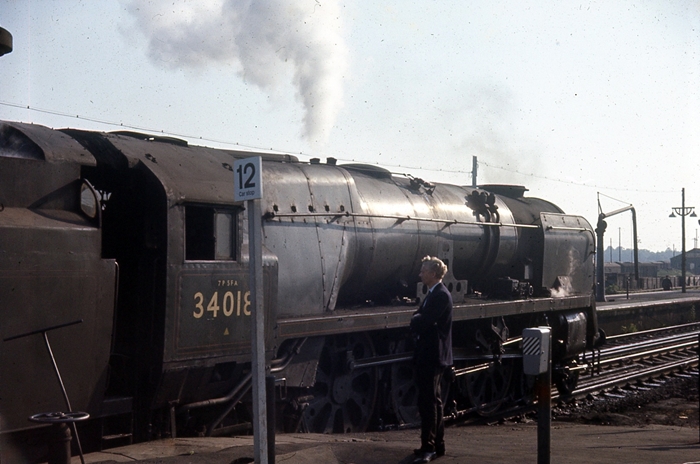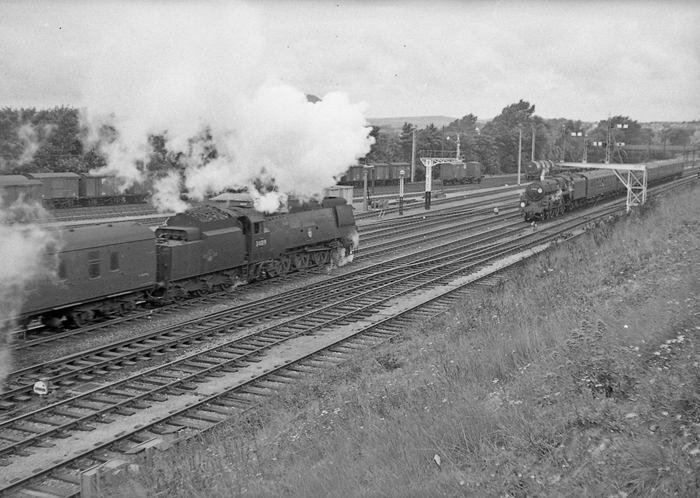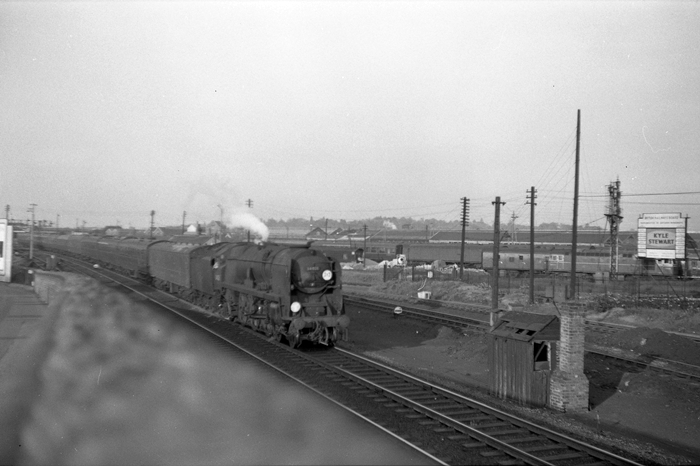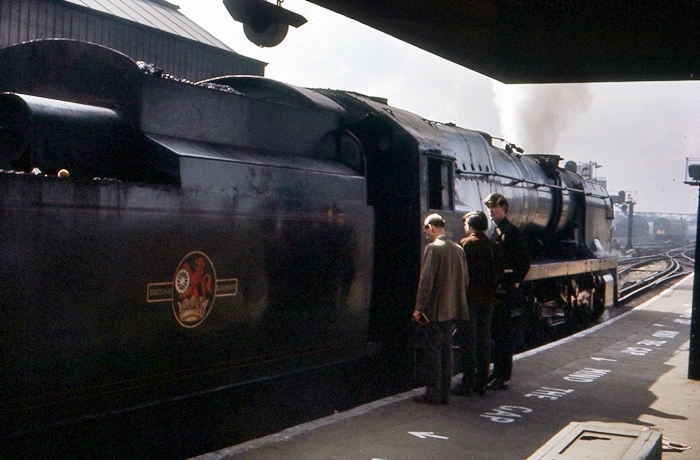
Bulleid Light Pacific
West Country / Battle of Britain Class
A Change of Naming Policy
Engines were outshopped in Malachite Green with yellow lining. The first
examples were dispatched to the SR’s far west outpost, the ‘’Withered Arm’’,
working between Exeter and Ilfracombe/Plymouth. By the end of 1946, twenty-seven
of the type were allocated to Exmouth Junction, in addition to the first five MN
engines, and the naming policy continued to be after places in the west country.
This changed in November 1946, when new builds started to receive Eastern
Section allocation. This was an interesting part of the SR network, for numerous
weight restrictions had seen the retention of a motley collection of ex-SE&CR
motive power to haul core express services. The SR had instigated a locomotive
renaissance in the district in 1925, when it started allocating ‘’King Arthur’’
(N15) Class engines to haul Victoria to Dover boat trains. To accept the
comparatively heavy locomotives, bridge strengthening exercises took place,
notable examples including that between Nunhead and Crofton Park on 24th May
1925, and a later reconstruction of the ‘’Chatham’’ line viaduct which passed
over the Medway Valley route at Strood, in 1927. In keeping with the
surroundings, Bulleid Light Pacifics started to acquire names associated with
the Battle of Britain, such as aircraft, airfields, squadrons, and individuals.
Stewarts Lane and Ramsgate, the former extensively enlarged by the SR in 1934
and the latter a completely new SR depot from 1930, received allocations of the
type. By 1947, Ramsgate had an allocation of twelve Light Pacifics, and Stewarts
Lane was home to eight of the type, this shed still commanding more than double
this number in ‘’King Arthur’’ engines. It was not until September of that year
that the first ‘’Battle of Britain’’ namings formally took place.
Nationalisation
British Railways formally came into existence in January 1948, and in September
of the following year, Bulleid left the service of the former SR, transferring
to Dublin. There, he became Consulting Mechanical Engineer for ‘’Coras Iompair
Eireann’’ (Irish State Railway), and was subsequently promoted to Chief
Mechanical Engineer. It is alleged that the move was in light of his reduced
autocratic power, which he previously enjoyed under the Southern Railway – it
was also reported that he vehemently opposed the nationalisation of the
railways.
By 1948, seventy Light Pacifics were in service and twenty of the larger MN
Class had been built, but production was not to end there. The works at Brighton
and Eastleigh continued to churn out new builds throughout January, perpetuating
Bulleid’s unique ‘’S’’ prefix numbering system. By the following month,
renumbering of the entire locomotive fleet of the then newly-formed BR began,
and new ‘’Spam Cans’’ emerged under a more conventional numbering arrangement.
The MN Class were renumbered in the range 35001 to 35020, and West Country /
Battle of Britain engines became Nos. 34001 to 34070. The first new Light
Pacific to emerge under BR auspices was No. 34071, in April 1948, which was
later to become ‘’601 Squadron’’ at a naming ceremony in September of the same
year. By May 1950, Brighton and Eastleigh Works had completed 109 Light Pacifics
between them, but the final locomotive, No. 34110, remained outstanding on
order. Since existing locomotives had been plagued by problems caused by the
chain-driven valve gear and oil bath, it was considered equipping the final
example with more conventional valve gear. However, in January of the following
year, No. 34110 (later named ‘’66 Squadron’’) emerged with the Bulleid
arrangement.
Mention should also be made of the locomotive exchange trials of 1948, which saw
a trio of ‘’West Country’’ engines acquire, if only temporarily, ex-LMS Stanier
tenders. Nos. 34004, 34005, and 34006 were so treated, and during May of that
year, all were destined for alternate ‘’foreign’’ routes. Of the four erstwhile
major railway companies, the SR was the only one not to have fitted water
troughs to any of its routes, and naturally, none of its locomotives were fitted
with water pick-up apparatus, which necessitated the pairing of the Bulleid
engines with alternate tenders. By the same token, a number of locomotives
visiting SR metals were paired with ''Austerity'' eight-wheel tenders, which had
large water capacities. No. 34004 ‘’Yeovil’’ went far from Southern territory,
and worked the scenic ‘’Highland Line’’ between Perth and Inverness. No. 34005
‘’Barnstaple’’ was deployed on the ex-Midland Railway trunk line between St Pancras and Manchester (Central), whilst No. 34006 ‘’Bude’’ appeared on the
parallel-running ex-Great Central route between Marylebone and Manchester
(Road). In May of the following year, No. 34059 ‘’Sir Archibald Sinclair’’
underwent trials between Liverpool Street and Norwich. Further Light Pacifics
arrived on the Eastern Region in May 1951, Nos. 34039 ‘’Boscastle’’, 34057
‘’Biggin Hill’’, and 34065 ‘’Hurricane’’ all receiving Stratford allocation.
They were soon joined by Nos. 34076 ‘’41 Squadron’’ and 34089 ‘’602 Squadron’’,
and all returned to Southern metals in 1952.
It is also worth making brief mention of the short-lived oil burning programme
undertaken on a small number of engines, which had been instigated by the
Southern Railway. In July 1947, work began on converting No. 21C119 ‘’Bideford’’
to run on this form of fuel, which involved installing an oil tank in the former
coal bunker of the tender. It was intended to convert a total of thirty Light
Pacifics to oil burning and in the months immediately after nationalisation, No.
21C136 ‘’Westward Ho’’ became the second candidate. The programme went no
further: by summer 1948, both engines had been converted back to coal engines,
as it transpired that oil could no longer be sourced cheaply from abroad.
As touched upon earlier, the first livery to adorn these locomotives was that of
Malachite Green, with yellow horizontal lining upon the air-smoothed casing and
tender, the latter also displaying ‘’SOUTHERN’’ in Sunshine lettering. After
nationalisation, this livery was briefly perpetuated on new builds, but
‘’SOUTHERN’’ was replaced by ‘’BRITISH RAILWAYS’’ on the tender, albeit still in
the same Sunshine lettering. In addition, from February 1948 onwards, the unique
Bulleid numbering system was replaced by a standardised BR format, but even this
continued to be applied in the Sunshine style. All was to change when, in August
of the following year, No. 34039 ‘’Boscastle’’ emerged wearing BR Brunswick
Green livery, which was to become the standard scheme for the locomotives
hereafter. The larger MN Class engines witnessed greater livery variation
throughout their existence, wearing a wartime black scheme and, latterly, BR’s
experimental blue colours (which, admittedly, suited the ‘’Spam Cans’’ well) –
hopefully, these will be discussed in greater detail in a separate website
section for the MN class in due course.
34018

A grubby No. 34018 ''Axminster'' is depicted at Woking on 16th June 1967, fronting the 17:00 Exeter relief. The engine entered service in December 1945 as No. 21C118, but was not officially named until June of the following year. Rebuilt in September 1958 and eventually withdrawn from Nine Elms in July 1967, the engine was scrapped at Cashmore's in Newport, South Wales, in April 1968. © David Glasspool Collection
34019

No. 34019 ''Bideford'' charges out of Weymouth in 1964 as a BR Standard 5MT nears journey's end. No. 34019 entered service in December 1945 as 21C119, it formally being named ''Bideford'' on 29th August of the following year. It avoided being rebuilt, and remained in service until March 1967. © David Glasspool Collection
34021

No. 34021 ''Dartmoor'' is seen passing non-stop through Eastleigh in 1965, with a Bournemouth express. The locomotive entered service in January 1946 as No. 21C121, and received its BR number in July 1948. It was rebuilt in December 1957, and remained in service until the end of SR steam, July 1967. © David Glasspool Collection
34021

Now shorn of nameplates, but in cleaner condition than in the previous photograph, we see our old friend No. 34021 ''Dartmoor'' once again. The engine is seen at Waterloo fronting the 10:00 relief to Exeter on 10th June 1967. At Salisbury, the engine would be replaced by a WR Diesel Hydraulic. In the background, a 4 SUB can be seen approaching, wearing BR (S) Green with small yellow warning panel. © David Glasspool Collection
<< Previous Next: The History Continues >>
Return to the Kent Rail Homepage or alternatively, check for Updates.
Website & Copyright information - Links - Contact the Webmaster
All content is copyright © David Glasspool unless otherwise stated